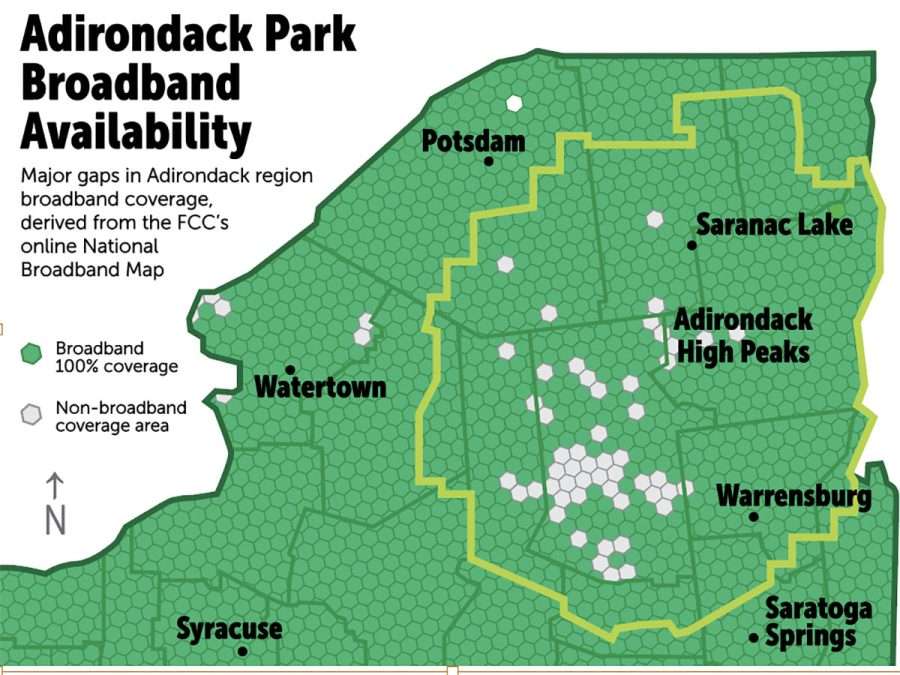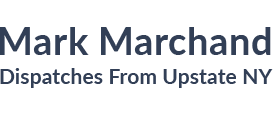
While broadband is available to most Adirondack residents, gaps remain
By Mark Marchand
Not since railroads and highways transformed access to the Adirondacks has the region stood poised to dramatically improve the area’s connectedness over a more metaphorical “highway.”
Dozens of collaborators—regional advocates, economic development officials, local/regional elected officials, and state/federal agencies—are working to take advantage of one part of the 2021 federal infrastructure law designed to expand availability of broadband internet access to even the most remote areas. One area activist describes the effort in terms of global events.
“It took a worldwide pandemic to remind us how critical access to broadband is here and elsewhere,” says Dave Wolff, member of the board of directors at AdkAction, a Keeseville-based non-profit that advocates for the region.
Other regional officials point to the medical needs of residents. District 7 Franklin County Legislator Melinda Ellis says the use of internet links is critical for health service. “Telehealth visits are an encouraging development for rural regions like ours,” she says. “But we understand that over the last few years about 30 percent of telehealth visits in our region failed because reliable, effective broadband wasn’t available.”
Another collaborator, Lake George Regional Planning Board Executive Director Beth Gilles, says broadband availability has evolved to the point where even in rural areas it’s a matter of survival for local businesses. Some entrepreneurs who relocate to the Adirondacks are disappointed when they learn there’s no broadband or only slow-speed links. “And even some local businesses that have been here for years and want to be able to reach customers outside the region find they cannot because of the lack of broadband.”
Wolff, Ellis, Gilles and many others are helping with a data-based examination of where broadband is available today and, more important, where it’s not. What the collaborators learn will be used to potentially expand broadband deployment under the new federal program.
Broadband is generally defined today as the ability of a home or business to download information from the internet at a speed of at least 100 megabits per second—a swiftness and capacity that dwarfs those once seen with dial-up modems and even early DSL phone company products and cable TV company modems. Broadband is also defined as the ability to upload information to the internet at speeds of at least 20 megabits per second. This would allow residents and businesses to easily send large files such as videos, music, data spreadsheets, and other documents to others over the internet.
More money for infrastructure
Most Americans understand that the massive 2021 federal Infrastructure Law is designed to pour about $550 billion into repairing and upgrading crumbling bridges, roads and other physical structures. Almost daily news conferences held against the backdrops of aging highways and rusty bridge girders underscore the notion.
But within the sweeping measure, making up more than 10% of the planned four-year outlay, is $65 billion for broadband access to provide more critical links to the 21st century world for residents, educators, businesses and others across the nation. Authors of the bill say over 30 million Americans live without access to the physical infrastructure that could connect them to the internet and worldwide web.
The process
The painstaking, often tedious work now underway in the North Country involves generating more awareness of the effort and careful examination of two interactive online maps: one offered by the Federal Communications Commission (FCC), and one provided by the New York Public Service Commission.
Both represent what the agencies believe is the current state of broadband availability throughout the country and in New York, using the most recent data they had. The maps depict broadband serviceable locations or addresses where broadband is available. They also show where addresses are underserved, meaning internet access at slower speeds, or not served at all. Residents and businesses can go online today, plug in their address, and quickly learn their broadband status.
Under a process created by the new federal program, residents and others who discover wrong information can file a “location challenge” with the FCC and/or the state. Often the inaccuracy relates to a wrong address, a new home or business erected since data for the maps was collected, or erroneous information provided by telecom carriers or others. But even this process can be difficult for some unaccustomed to navigating interactive websites.
“Think about residents who don’t even have access to broadband to do this research from home,” says Ellis. In those cases, legislators and other officials like her educate residents about how libraries and other public facilities will not only provide free internet access for the process but they can help visitors learn how to use the FCC or state maps.
Timeline of the program
The first deadline to make challenges passed on Jan. 13 but Wolff and others involved in the effort emphasize that this will be a “continuous” process. Residents can still conduct research and, if necessary, file a challenge if the information related to their own address is incorrect.
The FCC is now working with broadband wireline, or landline, carriers such as Verizon, Spectrum and Frontier and fixed wireless companies such as T-Mobile and Verizon to compare broadband serviceable location data and resolve discrepancies. This process will continue until the end of June when the data will be handed over to the National Telecommunications and Information Administration (NTIA). This federal agency, among other goals, works to bring the benefits of advanced telecommunications technologies to millions of Americans in rural and underserved urban areas. NTIA will begin allocating dollars to the 50 states sometime after June 30, based on where the data show more broadband should be built. States will then launch their own programs to work with telecom companies and communities to provide funds to further build out broadband.
In New York, the receiver of the federal funds will be the CONNECTAll office within the state’s Empire State Development agency. According to CONNECTAll’s Senior Vice President Joshua Breitbart, his team is already developing a five-year plan to work statewide and locally with communities and telecom providers to make the needed broadband construction investments.
“As it is now, the key to our efforts will be to continue working with our local partners,” Breitbart says. He adds that the new federally funded effort will continue the state’s momentum started with the New NY Broadband Program that was launched in 2015 with a $500 million investment. That program has already resulted in the deployment of over 21,000 miles of the fiber-optic cable considered to be the best technology for broadband to homes and businesses because it can be continually upgraded by adding new electronics—without having to upgrade or install new glass fibers and laser-based signaling equipment. The second-best technology are cable networks over coaxial wire partially fed by fiber. Recent advancements in what are known as fixed wireless services, usually provided by cellular companies, are becoming a more viable option for more difficult-to-reach areas.
Part of the process at the state level will be analyses of which technology and associated costs are appropriate for a specific location. The more expensive fiber-optic approach, for example, might not be ideal while another solution, such as fixed wireless, could work.
“We will continue to build on the momentum here in the state,” Breitbart stresses, “but where we are now, by and large, is trying to reach areas in more challenging terrain and those that are less densely populated,” which represent financial challenges for telecom companies to reach. With the new federal program, he adds, “We’re in a good position to go ahead and meet these challenges.”
The long-range view
As an active participant and promoter of the current effort, Wolff breaks down the process of expanding broadband to five steps: availability of a physical broadband connection at an address (hopefully a high-speed, high-capacity fiber-optic or coaxial cable link), the offering of a broadband service plan, the ability to afford a subscription to internet access, access to the equipment needed to use the service (modems, etc.) and, finally, having the skills to be able to connect the service to a computer and access the internet.
“Without that first step we’re lost,” Wolff says. “That’s what we’re involved in now. Every address that’s missing from the broadband maps essentially means more funds to expand broadband service. Ultimately our goal is to make sure New York and our region receive the maximum amount of funding available for this crucial infrastructure.”
